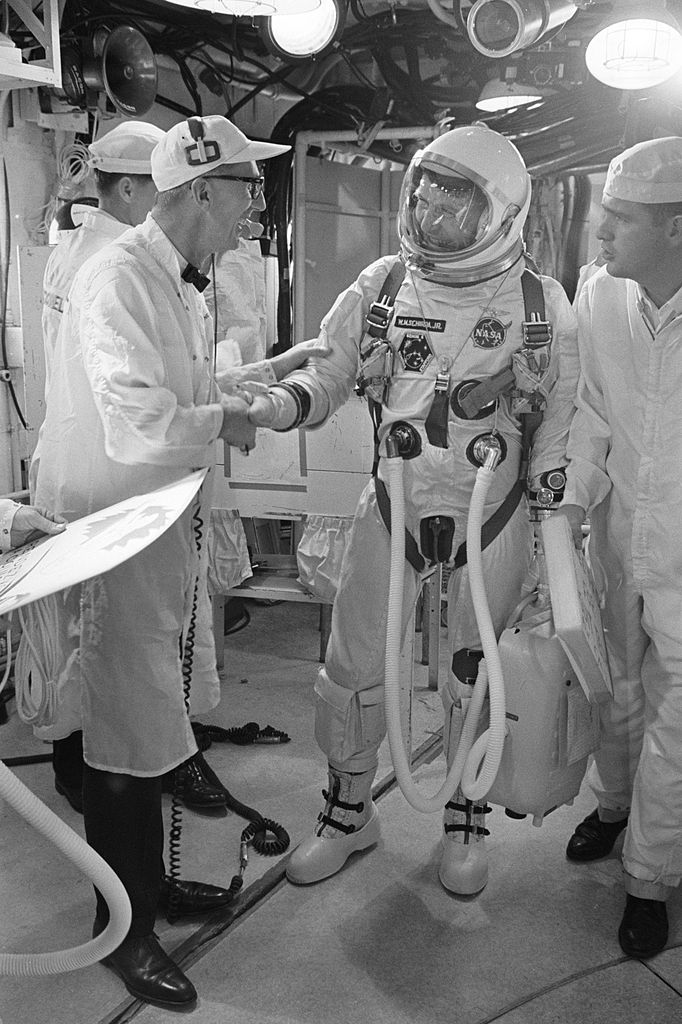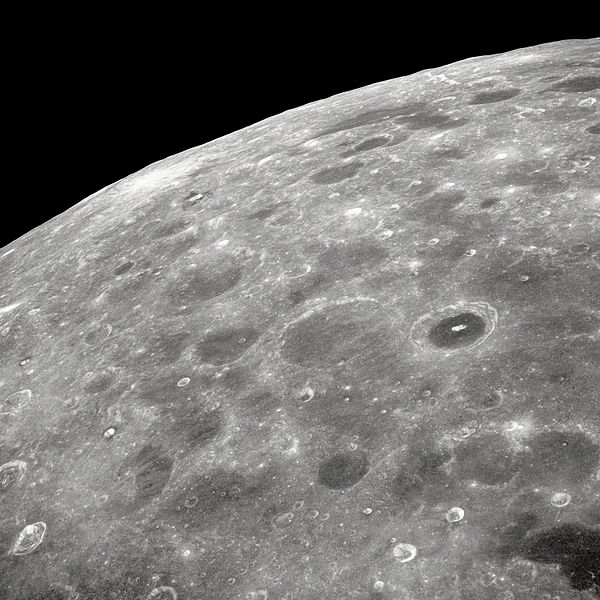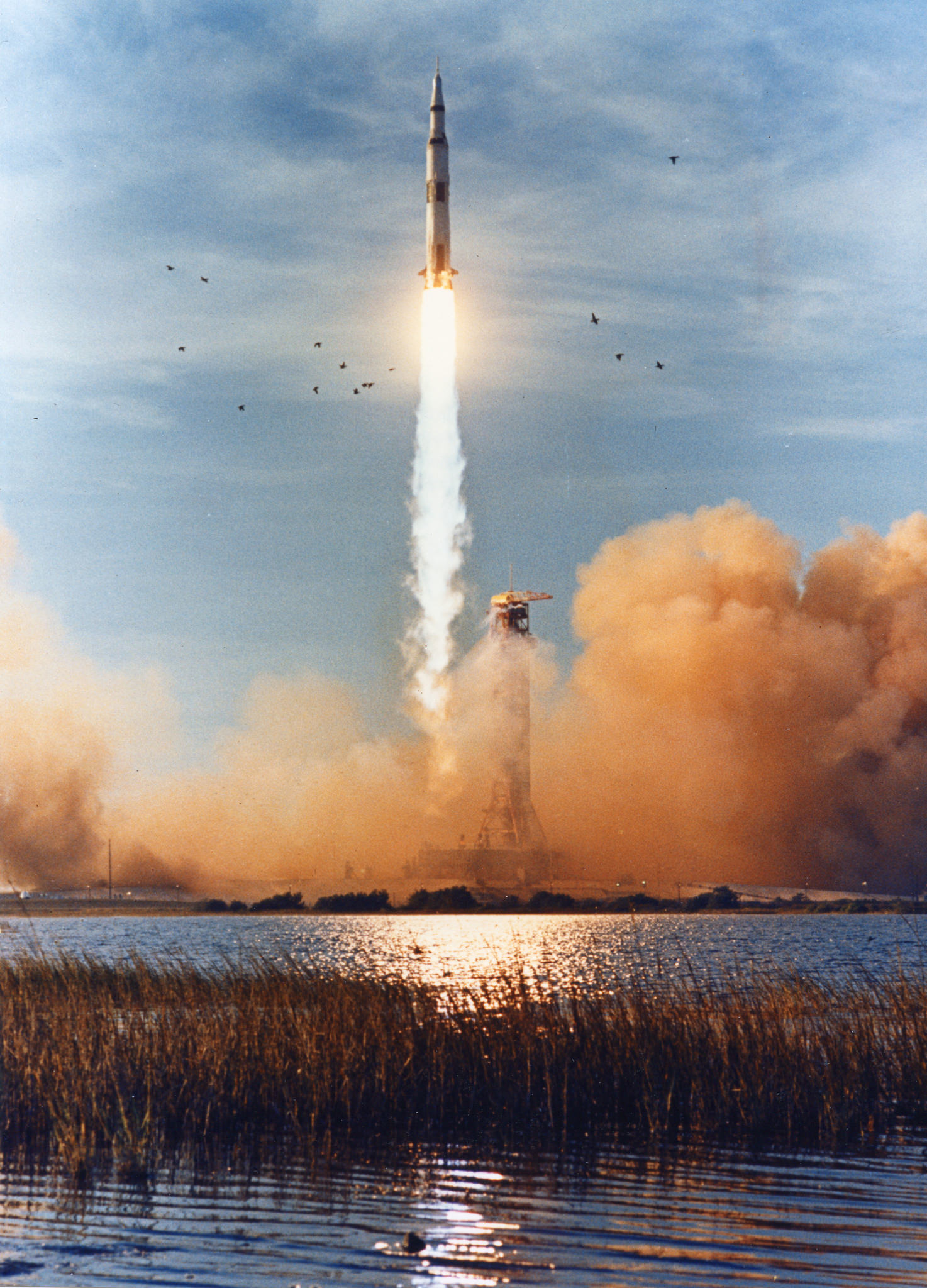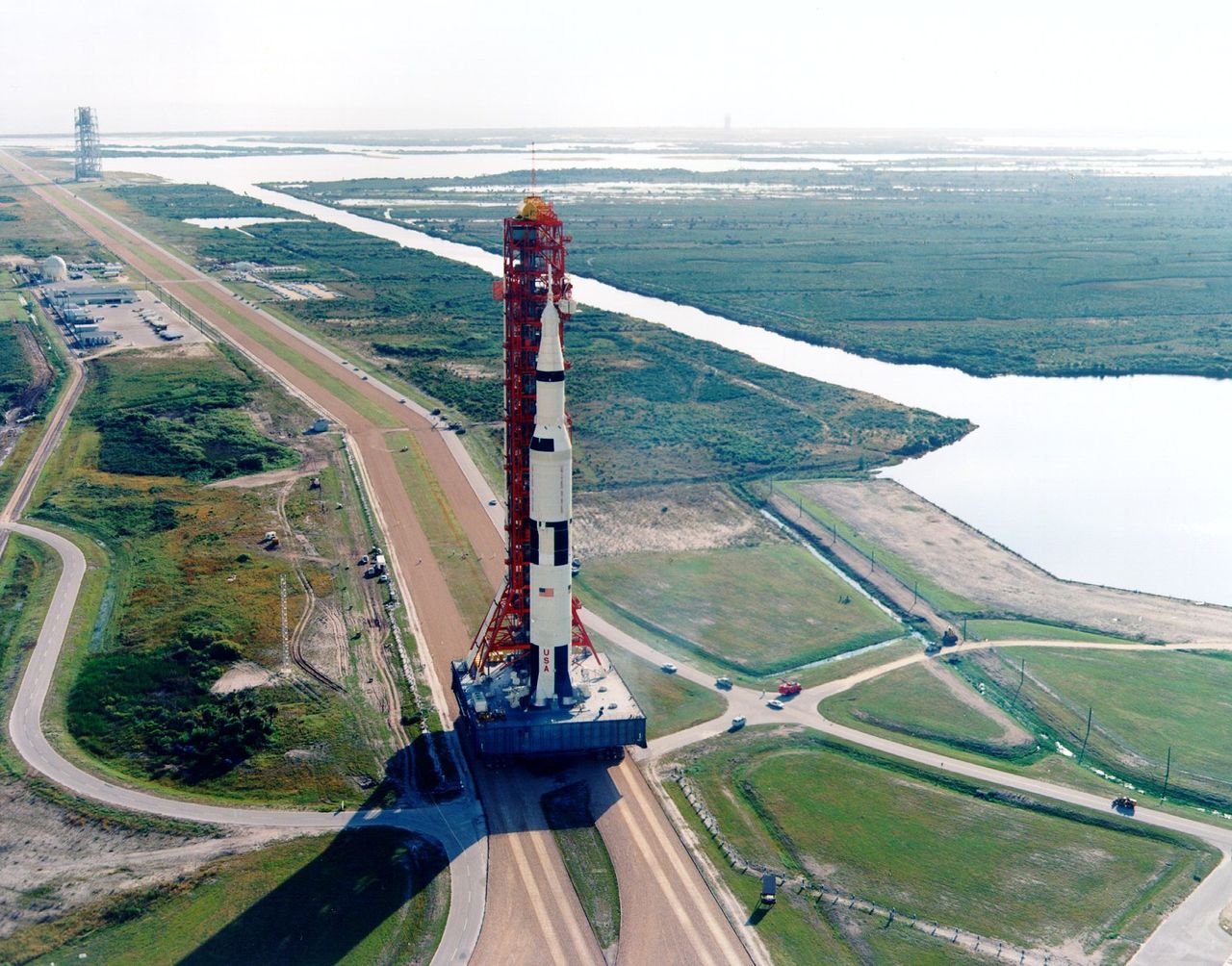Man on the Moon
1968 - 1969: One giant leap for mankind...
It's now 1968, and the world wakes up and reads the daily news. America's war in Vietnam continues to deteriorate. The Battle of Khe Sanh, which will be one of the most controversial battles of the war is well underway, and the Battle of Lima Site 85 has just resulted in the largest single ground combat loss of U.S. Air Force troops. Aer Lingus Flight 712 has crashed only a few days before en route from Cork to London near Tuskar Rock, Wexford, killing 61 passengers and crew. Only a week ago, Charles "Charlie" Chaplin Jr died aged just 42.
And now, on March 27, while on a routine training flight from Chkalovsky Air Base, Yuri Gagarin and flight instructor Vladimir Seryogin are killed in a MiG-15 crash near the town of Kirzhach.
It was the latest in a series of blows which the Soviet team didn't need. The N1-L3 project was beset with issues, and it had become clear they wouldn't be capable of performing a lunar orbit before America. Sergei Korolev's dream of a Russian on the moon lay in tatters.
Meanwhile in America, the Apollo 4 mission marked the first full test of the completed Saturn v. Launched on Novermber 9, it proved the potential of the huge system. Then on January 22 1968, the new Apollo lunar module was sent up and tested as part of the Apollo 5 mission, followed by Apollo 6 in April. The Apollo program had suffered huge delays, but even so, it looked increasingly likely that Kennedy's dream of man on the moon before the end of the decade would be met, if only just.
In the aftermath of Apollo 1, changes were made to the systems on the Command/Service Module and the team worked on trying to build as much safety and solidarity into the system as possible. This went beyond simple engineering and into changes in personnel. On that, throughout the Mercury and Gemini programs, Guenter Wendt, who'd been an engineer for McDonnell Aircraft, had been leader of the spacecraft launch pad teams, starting with the flight of Ham the chimpanzee seven years earlier. His role meant he was the person whom the astronauts would see, and as such he'd become something of a good luck totem to the crews. He also had ultimate responsibility for condition of the spacecraft at launch. Upon discovering that one engineer intended to personally make a spacecraft change, with or without his permission, Wendt called security and had him removed.
The guy comes up on the elevator and he says, 'You like me to put handcuffs on you, or are you going to go by yourself?' The engineer dropped his jaw, but he left. Maybe this system is wrong, but I have had pretty good success with it. If I don't do a good job, I get out. I can't compromise.

His diligence, care and knowledge had earned the astronauts' respect and admiration. On Apollo 1 though, the contractor for building spacecraft for NASA had changed from McDonnell to North American Rockwell, so Wendt was not the pad leader at that time. After the accident, several people expressed that they wished Wendt that he had been the pad leader that day, as they felt he might have caught the fatal problem. Wendt himself didn't believe it. On the missions since then though, other people had taken the role. And whilst the other astronauts might have been OK with someone else, Walter Schirra, Commander of the Apollo 7 mission, wanted his man back.
Schirra got Deke Slayton, one of the original Mercury Seven astronauts and now Schirra's boss to persuade North American to hire Wendt away from McDonnell. Then Schirra personally lobbied North American's launch operations manager to change Wendt's shift from midnight to day, so he could be pad the leader for Apollo 7. Not only did he get his way, but Wendt went on to remain as Pad Leader for the rest of the Apollo program, through the Skylab and then on to later missions. He'd continue to work at the Kennedy Space Center until 1989.
Apollo 7 launched October 11, having been given it's blessing by Wendt.
The First Lunar Missions
Change was the order of the day throughout NASA in 1968. Administrator of NASA James Webb was a Democrat who had been closely associated with the President Johnson. However, with the Apollo 1 disaster, and Johnson choosing not to run for re-election, he decided to step down. The next President (which would in January of the next year be Republican Richard Nixon) would therefore be free to choose his own administrator.
Whilst still in his position though, Webb had been informed by the CIA that it appeared the Soviet Union was developing its own rocket for a manned lunar mission. They'd obtained photographs of the N1-L3, and knew what it would be capable of if it worked. As a result, he directed NASA to prepare Apollo 8 for a possible lunar orbital mission that year. Webb himself though didn't believe the Soviet rocket would fly, and felt that their political issues would ensure that the US was able to get to the moon first. These views were doubted in some quarters, however, later revelations about the N1 would end up proving Webb's conclusions. Nevertheless, in October 1968, just before the first manned flight in the Apollo program, Webb left NASA. Two months later, NASA drove the final nail into the coffin of the dreams of the Soviet team, with the launch of Apollo 8. For Wernher von Braun, the man who imagined up the mighty Saturn V, the dream of putting a man of the moon was had come a whole lot closer.
Apollo 8
It's December 21 1968, and Apollo 8 sits on the pad at the Kennedy Space Center. It's to be the first human spaceflight from Kennedy, and tensions are mounting. Work on the Lunar Module has proved slow, and has delayed progress. As a result, the decision was been made by George Low, the Manager of the Apollo Spacecraft Program Office, back in August to change the mission to a more ambitious goal: a lunar orbital flight. This mission won't require the Lunar Module, but it'll make the first human flight around the moon. The crew, consisting of Commander Frank Borman, Command Module Pilot James "Jim" Lovell and Lunar Module Pilot William Anders have had an accelerated training schedule, their mission having been bumped up by several months. It's left them with less time for training and preparation.
The upshot is that the new mission, if successful, will allow the team to test the lunar landing procedures that would otherwise have to wait until Apollo 10, the last mission before the planned lunar landing. It'll also mean almost certainly beating the Soviets to a circumlunar flight, providing a huge boost in morale. There was a lot of pressure to get a human mission to the moon first, as in September the Soviet team had launched the Zond 5 with a Proton-K rocket, which had taken amongst other things two Russian tortoises around the moon and back again. The fear was that with that success, surely a manned mission couldn't be far off.
The night before the launch, the Apollo 8 crew received a visit from Charles Lindbergh and his wife Anne at Kennedy Space Center. They talked about how, before his legendary 1927 flight aboard the Spirit of St. Louis from America to France, Lindbergh had used a piece of string to measure the distance from New York City to Paris on a globe to calculate the fuel needed for the flight. Incredibly, it had been accurate. Saturn V would burn tens times the amount Lindbergh had used for that entire flight every second. The next day, from a dune near the launch site, the Lindberghs settled in to watch the launch of Apollo 8.
The mighty rocket launched at 07:51am local time on December 21 and blasted off into space, reaching it mere minutes later. The previous series of rockets used by NASA to put people in to space, the Titan II, had been notoriously uncomfortable at launch, with harsh vibration and huge noise. The design of Saturn V promised a less jarring ascent, having designed the system specifically for the Apollo program rather than adapting an existing missile for the task. Lovell and Borman, both who had both flown on the Titan II, were not disappointed. During liftoff, they reported feeling nothing but a dull, muted rumble in the distance.
Once the vehicle reached Earth orbit, both the crew onboard and the Houston flight controllers on the ground spent the next 2 hours and 38 minutes checking all was ready for the journey to the moon, while the rocket orbited the Earth. Having satisfied themselves that everything was in good order, less than three hours after launch, the stage IV booster fired, and the crew were off to the moon.
As Apollo 8 started its journey, the crew began to put the ship into a "barbecue" roll, or Passive Thermal Control (PTC) to give it its proper name. This would mean the spacecraft would rotate steadily around once every hour. This slow roll allowed for even heat distribution as it was heated by the Sun. The part under direct sunlight could reach temperatures as high as 392 °F (200 °C), while the shaded side plunged to −148 °F (−100 °C). If these temperatures were sustained, they could cause the heat shield which would keep the crew alive in reentry to crack, or cause other damage to the craft. This roll was a constant manoeuvre, requiring refinement around twice per revolution to ensure the ship stayed pointing in the right direction, and that the roll was kept as tight as possible.
This was possible as it was required that one astronaut was to be kept aware at all times, to ensure someone was always ready to respond to any issues. However, between the constant communication with the ground, and the noises of the ship, sleeping wasn't particularly easy anyway. By the second day in to the flight however, the difficulty posed in sleeping in space, combined with space sickness created by the increase space to move and the team therefore moving around the craft grew so great that the crew gave up on their planned schedule and simply slept when they could, with whoever was least tired staying awake.
64 hours into the flight, the crew began to prepare for Lunar Orbit Insertion, to fly around the far side of the moon. This manoeuvre had to be performed perfectly, and on the far side of the Moon, out of contact with the Earth. After Mission Control polled for a "go/no go" decision, the crew was told they were Go. Thus, at 68 hours and 58 minutes and travelling at 24,200 mph (38,938 km/hr), the crew and their ship shot behind the Moon and out of radio contact with the Earth.


The rocket engines now fired and burned for 4 minutes and 13 seconds, placing the Apollo 8 spacecraft in orbit around the Moon. They'd spend the next 20 hours in orbit, flying around it ten times, orbiting at adsf. After coming back around and resuming contact with Earth, Lovell reported on the status of the spacecraft and then became the first man to give a description of a first-hand close-up look at the lunar surface:
The Moon is essentially grey, no color; looks like plaster of Paris or sort of a grayish beach sand. We can see quite a bit of detail. The Sea of Fertility doesn't stand out as well here as it does back on Earth. There's not as much contrast between that and the surrounding craters. The craters are all rounded off. There's quite a few of them, some of them are newer. Many of them look like—especially the round ones—look like hit by meteorites or projectiles of some sort. Langrenus is quite a huge crater; it's got a central cone to it. The walls of the crater are terraced, about six or seven different terraces on the way down.
On its forth orbit, for the first time, the crew witnessed something else no other humans had ever seen: Earthrise. Borman was the first to notice it and called to the others, while taking a black-and-white photo. In the ensuing scramble Anders took the more famous colour photo, later picked by Life magazine as one of its hundred photos of the century.
Anders: Oh my God! Look at that picture over there! There's the Earth coming up. Wow, is that pretty. Borman: Hey, don't take that, it's not scheduled. (joking) Anders: (laughs) You got a color film, Jim? Hand me that roll of color quick, would you... Lovell: Oh man, that's great!
Then, on December 24, they began a second television transmission. Borman introduced the crew to the world, followed by each giving their impressions of the lunar surface and how it felt to be orbiting it. After, they made the following short speech, with each man reading a section.
With that done, all that was left to do was to leave the lunar orbit, return to Earth, and land. Two and a half days later shortly before reentry, the crew were let in on a secret: Deke Slayton has arranged a surprise Christmas dinner. A real turkey with stuffing, in the same kind of pack that the troops in Vietnam received had been placed aboard for them so they could celebrate. Having eaten and prepared, the crew prepared for reentry. On December 27, 15:51 and 42 seconds, their mission ended, the team landing in the North Pacific, just south of Hawaii. It ended a turbulent year, which had seen violent unrest in Europe and America, the invasion of Czechoslovakia, assassinations, the deaths of Helen Keller, Martin Luther King Jr, Kennedy, Gagarin and more.
The effect on the world of Apollo 8 was perhaps best summed up by a telegram from a stranger, received by Borman after the mission. It read:
Thank you Apollo 8. You saved 1968.
Turning Up to 11
Apollo missions 9 and 10, whilst still important, didn't have the same electrifying effect as 8. Instead, they were seen as preparatory missions for the flight of 11. Apollo 9 though still saw the first flight of both the Command/Service and Lunar Modules (CSM and LM respectively), whilst 10 was a full dry run of the 11 mission, testing every procedure except for the actual landing itself. Both provided valuable data, and kept America firmly as being seen in the driving seat.
Back in the USSR, things weren't going so well. On the positive side, January saw Soyuz 4 and 5 operate the first successful transfer of crew between two craft, the crew members conducting spacewalks between the two vessels. Back on the ground though, the first test of the N1 was about to happen, and it wasn't going to go well.
February 21 1969. The N1 stood on the pad at the Baikonur Cosmodrome. The countdown ticked away, and finally Korolev's rocket started. Almost three dozen engines fired, and the rocket began to lift into the air. A few seconds into launch though, things went disastrously wrong. Engine 12 of the first stage shut down, leading to engine 24 shutting down to maintain symmetrical thrust. Intense vibrations rippled through the vehicle, which caused the rupture of a line providing explosive oxidizer. Next, a fuel line ruptured, leaking fuel into the aft section of the booster. The resulting fire incinerated its way through wiring, causing electrical arcing which moments later results in the rocket's control software shutting down the entire first stage. That signal was also sent to the second and third stages, which very effectively stopped the ground controllers from controlling anything whatsoever. The mighty N1 fell from the sky, plummeting for over two minutes, before smashing into the ground 32 miles (52 km) away.
Five months later on July 3rd, the team tried again. This time, the rocket blasted off but things went wrong even more spectacularly. Upon clearing the tower, all the engines bar one shut down, causing the rocket to tip over and fall back on to the pad. Around 15% of the onboard fuel detonated with the force half that of the nuclear weapon dropped on Hiroshima, producing an explosion visible from 22 miles (25 km) away. The rest was blasted into the air, where it rained down for over an hour. The vast explosion scattered debris over an area six miles (10 km) wide. The detonation, which remains possibly the most powerful non-nuclear man-made blast, destroyed the launch pad causing damage which would would take 18 months to repair, and ended the Soviet dream of placing a man on the moon before the USA.
Having failed to win the space race, the doomed N1 would attempt two more launches in 1971 and 1972. Both would also result in the loss of the rocket involved. Korolev's grandest design, with it's vast engine count, was cancelled in May 1974. It never once managed to fly successfully. The unmitigated disaster of the program was made a state secret and not revealed until 1989.
Apollo 11
Back in 1969 however, excitement grew. The Saturn V had performed flawlessly so far and preparations were being made for its most important mission: the landing of man on the moon. The crew was to be Commander Niel Armstrong, Command Module Pilot Michael Collins, and Lunar Module Pilot Edwin "Buzz" Aldrin. Originally, Jim Lovell had been slated for CMP, whilst Collins was slated to be the CMP on Apollo 8. However, Collins was bumped after needing surgery on his back. As a result, after Collins was medically cleared, the two men had swapped positions. Lovell was transferred to Apollo 11's backup crew, but promoted to be backup commander.
The rest of the backup crew consisted of CMP William Anders, and LMP Fred Haise. Lovell and Haise would be joined by Ken Mattingly, who had recently been moved from support crew into parallel training with Anders as backup CMP in case Apollo 11 was delayed, as the primary crew for the Apollo 13 mission. The support crew Capsule Communicators, known as CAPCOM, themselves also all astronauts were:
- Charlie Duke (Apollo 16)
- Ronald Evans (Apollo 17)
- Owen K. Garriott (Skylab 3, STS-9)
- Don L. Lind (STS-51-B)
- Ken Mattingly (Apollo 16, STS-4, STS-51-C)
- Bruce McCandless II (STS-41-B, STS-31)
- Harrison Schmitt (Apollo 17)
- Bill Pogue (Skylab 4)
- Jack Swigert (Apollo 13)
The mission itself was run by three flight directors:
- Cliff Charlesworth (Green Team), launch and EVA
- Gene Kranz (White Team), lunar landing
- Glynn Lunney (Black Team), lunar ascent
The rocket was fuelled, and the countdown started at Launch Complex 39, Kennedy Space Center. The hours counted down. Finally, at 9:32 exactly on July 16 1969, Apollo 11 took flight.
12 minutes later, travelling at huge speed, the vessel entered Earth orbit at an altitude of 100.4 miles (185 km). Around two hours later, having completed the burn to send the ship out of orbit and towards the moon, the three astronauts made their way to the command/service module, and docked with the lunar module, removing it from the third stage of the Saturn V. Everything was set. They were on their way to the moon.
On the afternoon of July 19, Apollo 11 passed behind the Moon and manoeuvred to enter lunar orbit. The next day, astronauts Alrdin and Armstrong entered the LM, separated from the CSM, and began their descent to the lunar surface.
Apart from a minor computer glitch, the descent went smoothly at first. However, when Armstrong looked outside, he saw that the computer's landing target was covered in boulders, and next to a crater. Believing the landing was too dangerous to let the computer continue, Armstrong took control of the LM. As he began to pilot the descent, Aldrin started calling out navigation data. The fuel ran down, as Armstrong searched for a new place to land, sending the LM flying along sideways. Finally, at 20:17 and 40 seconds UTC, on July 20, Aldrin and Armstrong went through the final processes, before talking to Charles Duke, CAPCOM back on Earth.
Altitude
0 feet
Speed
0 feet per second
Time
00:00
Landing
15:05
CAPCOM/Eagle
Mission Control
Once Armstrong and Aldrin were ready to go outside, Eagle was depressurised, the hatch opened, and Armstrong made his way down the ladder. When he got to the base of the ladder, he radioed back:
I'm going to step off the LEM now.
He then turned and set his left boot on the lunar surface at 02:56 UTC July 21 1969, then to the 450 million people (about 12% of the world population) listening, spoke the famous words...
That's one small step for [a] man, one giant leap for mankind.
About 20 minutes later, Aldrin joined Armstrong on the surface, and the two men began set about their task list. They unveiled a plaque. commemorating their flight, and planted a United States flag in the lunar regolith. The plaque was mounted on the LM, and depicted the Eastern and Western hemispheres, and carried the inscribed signatures of the astronauts and President Nixon, along with the message:
Here men from the planet Earth first set foot upon the Moon, July 1969 A.D. We came in peace for all mankind.
Shortly after, President Nixon spoke to them via a telephone call from his office. Having taken a number of photos and set up an experiment package, their final task was to leave small package of memorial items to cosmonauts Yuri Gagarin and Vladimir Komarov, astronauts Gus Grissom, Ed White and Roger Chaffee. Despite never having reached the moon in their lifetimes, in spirit at least, the five men finally arrived.
A Victorious Return
Having re-entered the LM, the hatch was closed and sealed. They repressurised the LM and settled down to sleep. Unfortunately, Armstrong and Aldrin discovered that, thanks to having to move around in a bulky spacesuit, Aldrin had accidentally broken the ignition switch for the ascent engine. They solved the issue through the extremely technical procedure of pushing the circuit breaker with a felt-tip pen, which activated the launch sequence. The LM ascended, the exhaust knocking over the flag which had been planted too close, and docked with Columbia shortly after. All that remained was to leave lunar orbit and return. A few days later, on July 24, just five days after they took off, the three astronauts returned to Earth, the Columbia command module bringing them down in the Pacific Ocean.
Von Braun had lived to see his dream, and the dream of so many others, come true.
Back to part 3: The Challenge Set Continue to part 5: The Race Ends

